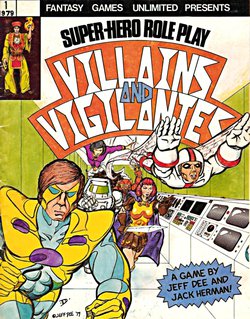I started to feel that I didn’t know roleplaying games well enough so I came up with the plan to read a roleplaying game corebook for every year they have been published. Selection criteria is whatever I find interesting.

Villains and Vigilantes is a superhero roleplaying game from 1979. I read it from a facsimile edition published in 2016 with a new preface explaining some of the original context of the game. Jack Herman, one of the game’s original designers along with Jeff Dee, talks about how they started with making a superhero hack of Empire of the Petal Throne, and then gradually pared away the elements of the older game until they had their own design.
This is the first roleplaying game I’ve read during this project where the title used for the person running the game is not Referee or Judge but Game Master. This has since become pretty much standard.
Another interesting first is a genre formulation. Perhaps it’s not surprising that I encounter this in a superhero game as the tropes of the genre tend to be more artificial than in many other genres. In this game, it’s defined as following the dictates of the Comics Code, the comics industry content code which sought to limit the types of stories, images and characters you could have to forestall external censorship. The most important tenet for Villains and Vigilantes is that you can’t, in fact, play a villain.
In terms of roleplaying game design, Villains and Vigilantes has one extremely interesting idea. When the players first come together to play the game, the GM is instructed to create characters with them based on themselves but with super powers. So I would play Juhana Pettersson with powers.
The method for determining the stats of the character is that the GM assesses these based on their knowledge of the player. It even says not to be too lenient with giving high stats. So the GM would look at me and go: “Hmmm… Kind of dumb looking. Let’s say Intelligence of seven.”
After the base character has been created with this method, superpowers are then randomly rolled from a set of tables.
After the players have played one game or campaign with themselves as the base characters, the next ones are not avatar-types but completely fictional. Thus, there’s design to guide how to change the nature of the game as the players get more experience with it, another first.
The aesthetic of reality is also extended to how the GM builds adventures. The game suggests two sources of inspiration: Marvel and DC comics and the nightly news. The idea is that the GM can just pick a topical real event and insert the superhero characters there.